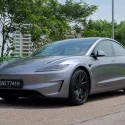When it comes to broadband, consumers in Singapore enjoy some of the fastest and most affordably priced broadband plans anywhere in the world. Today, telcos typically offer a couple of plans that vary in connection speeds to suit customers and their needs. These speeds are generally 3Gbps, 5 or 6Gbps, and 10Gbps.
The availability of these options is great for consumers. Still, it can also be confusing, especially if you aren’t well-versed in home networking. In a nutshell, choosing the right broadband plan boils down to two considerations: can you fully maximise the speed, and do you really need all that speed?
There are a few things to consider when it comes to maximising the plan’s speed. If you want to skip ahead, click on the content list below, otherwise, keep scrolling.
Home infrastructure
Key takeaway: Ensure your home network uses Cat 6 cables.

A wired connection will let you get the utmost from your high-speed broadband plan.
Photo: Tavis Online
One of the most important considerations when getting a new broadband plan is your home’s networking infrastructure. Most newer homes come complete with built-in network and data points, making it easy for owners to get internet connectivity throughout their homes. However, to fully maximise today’s high-speed broadband plans, you have to check that your cables used for networking are at least Cat 6 or Cat 6a, because these cables support speeds of up to 10,000Mbps. This means you’ll be able to fully maximise the speeds of these broadband plans, which also means you can freely choose from any of the broadband speeds.
Older homes might have networks built with Cat 5 cables. In this case, speeds will be limited to 1Gbps, which isn’t bad, but it means you cannot fully capitalise on the speeds of your new broadband plan. Redoing the network in your home will be a big undertaking and probably not feasible for most people. However, you can still use Wi-Fi to get speeds of over 1Gbps by connecting the ONT (optical network terminal) directly to a router. This is not ideal, but it may be good enough if your fibre termination point is a central enough location in your home. If you fall into this group of users, I’ll recommend limiting yourself to the 3Gbps or 5/6Gbps plans. Because you are relying on Wi-Fi, you’ll never be able to attain transmission speeds that can fully maximise the broadband plans. Hence, you are better off saving money by going with a cheaper plan with lower speeds.
Existing hardware
Key takeaway: Take advantage of all that speed with Wi-Fi 7 devices.

Wi-Fi 7 routers, when paired with a Wi-Fi 7 device, will get you the best wireless speeds.
Photo: Linksys
The next thing to consider, apart from your home network, is the types of client devices you have. This means what are you going to be connecting to your home network and your wireless devices, like your phones, laptops, and tablets.
For wired connections, you need to ensure your device has a high-speed Ethernet port, preferably one that is 10GbE, so that it can support speeds of up to 10Gbps. If your device doesn’t have it, consider if it can be added on. For example, you can get a 10GbE PCIE network card for your desktop. And even if your device doesn’t support 10GbE, it just means speeds will be capped at 1Gbps – which is still fast by today’s standards.
If you are mostly going to be relying on Wi-Fi, then you’ll need to consider the type of router you are going to be using and your wireless devices. I’ll touch on routers separately below, but as for your wireless devices, you will want them to support Wi-Fi 7. This is the latest networking, and it’ll enable you to consistently achieve speeds over 1Gbps when paired with the right Wi-Fi 7 router. Wi-Fi 6E isn’t good enough, and I covered why here.
Router considerations
Key takeaway: Get a Wi-Fi 7 router with WAN and LAN ports that matches your plan. If you want a 10Gbps plan, get a router that has 10Gbps WAN and LAN ports.

You’ll need a powerful router to take advantage of high-speed plans. Pictured here is the quad-band ASUS ROG Rapture GT-BE98 router.











